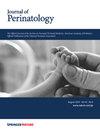Impact of prophylactic antibiotic duration on surgical site infection rate in neonatal surgery: a multicenter retrospective observational study
IF 2.4
3区 医学
Q2 OBSTETRICS & GYNECOLOGY
引用次数: 0
Abstract
To evaluate the relationship between the incidence of surgical site infections (SSIs) and the duration of perioperative antibiotic prophylaxis (PAP) in neonatal surgery, and to identify risk factors for SSIs in neonates. Eligible patients were neonates who underwent surgical procedures—primarily in the respiratory and gastrointestinal fields—between January 2014 and December 2023 at seven institutions. All data were retrospectively retrieved from electronic patient records. We estimated the risk difference using a modified least-squares regression model. Of the 983 patients included, 91 (9%) developed SSIs. A total of 735 patients (75%) received PAP for >24 h. There was no significant difference in risk when PAP duration was <24 h compared with ≥24 h. Independent risk factors for SSIs were an operative time exceeding 120 min, past surgical history, and open surgery. In neonatal surgery, a short duration (<24 h) of PAP may not increase the risk of SSI.

预防性抗生素持续时间对新生儿外科手术部位感染率的影响:一项多中心回顾性观察研究。
目的:探讨新生儿外科手术中手术部位感染(ssi)发生率与围手术期抗生素预防(PAP)时间的关系,探讨新生儿手术部位感染的危险因素。方法:符合条件的患者是2014年1月至2023年12月期间在7家机构接受外科手术的新生儿,主要是呼吸和胃肠道手术。所有数据回顾性地从电子病历中检索。我们使用改进的最小二乘回归模型估计风险差异。结果:纳入的983例患者中,91例(9%)发生ssi。共有735例患者(75%)接受PAP治疗,持续bbbb24小时。结论:在新生儿手术中,持续时间短(
本文章由计算机程序翻译,如有差异,请以英文原文为准。
求助全文
约1分钟内获得全文
求助全文
来源期刊

Journal of Perinatology
医学-妇产科学
CiteScore
5.40
自引率
6.90%
发文量
284
审稿时长
3-8 weeks
期刊介绍:
The Journal of Perinatology provides members of the perinatal/neonatal healthcare team with original information pertinent to improving maternal/fetal and neonatal care. We publish peer-reviewed clinical research articles, state-of-the art reviews, comments, quality improvement reports, and letters to the editor. Articles published in the Journal of Perinatology embrace the full scope of the specialty, including clinical, professional, political, administrative and educational aspects. The Journal also explores legal and ethical issues, neonatal technology and product development.
The Journal’s audience includes all those that participate in perinatal/neonatal care, including, but not limited to neonatologists, perinatologists, perinatal epidemiologists, pediatricians and pediatric subspecialists, surgeons, neonatal and perinatal nurses, respiratory therapists, pharmacists, social workers, dieticians, speech and hearing experts, other allied health professionals, as well as subspecialists who participate in patient care including radiologists, laboratory medicine and pathologists.
 求助内容:
求助内容: 应助结果提醒方式:
应助结果提醒方式:


